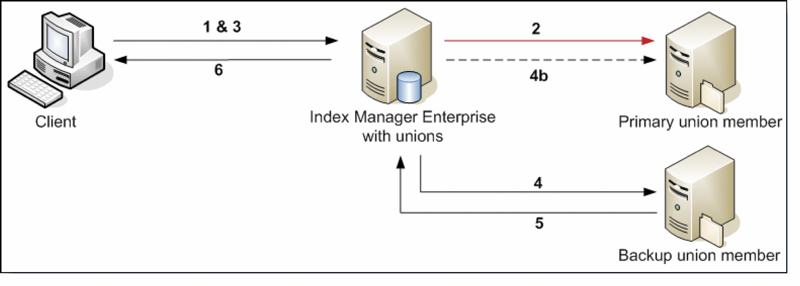
This appendix will go a bit more into detail regarding how a round-robin backup union member works.
The standard setup is almost as described for passive backup union members. The difference is that the backup union member is always online and accessible. A round-robin backup is used to balance the load on the Index Manager servers. The search requests are evenly distributed between the primary and the backup union member, the first search going to the primary union member, the second to the backup union member, the third to the primary union member, and so on.

During normal operation, a client sends a search request to the Enterprise server (1), which in turn forwards the request to the primary union member (2). The search is carried out by the primary union member and the search result returned to the Enterprise server (3), which in turn passes it on to the client (4). The next search request sent from the client to the Enterprise server (5) is now forwarded to the backup union member (6). The search is carried out by the backup union member and the search result returned to the Enterprise server (7), which in turn passes it on to the client (8).
The next search request sent from the client to the Enterprise server is now forwarded to the primary union member, and so on.

If the primary union members fails (note that the same would apply if the backup union member fails), then the situation is as follows:
A client sends a search request to the Enterprise server (1), which in turn forwards the request to the primary union member (2). Since the primary union member is not accessible, the search will time out after a while, and the client will receive a “Search Failed” error message. (The search timeout period is set when adding the primary union member to the union, and it can be changed by selecting the primary union member in question and clicking on the Properties button.)
The next search from the client is sent to the Enterprise server (3) and then forwarded to the backup union member as expected (4). The backup union member will now continue to receive search requests until the primary union member comes back online. Note that the Enterprise server continues to send search requests to the primary union member (4b) in an attempt to see if it becomes active again. The moment it does become active, the system returns to normal operation as described in the beginning of this chapter (i.e. round-robin distribution), and the distribution of searches between the primary and the backup union member is restored.